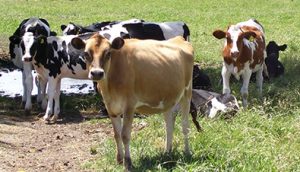Read the latest information on
Foot-and-mouth disease
 With a positive detection for Johne’s disease (JD) on a New South Wales north coast cattle stud having been confirmed by NSW DPI, questions about what this means for properties with a confirmed clinical case of JD have been asked, particularly in relation to the relatively new framework for management of the disease.
With a positive detection for Johne’s disease (JD) on a New South Wales north coast cattle stud having been confirmed by NSW DPI, questions about what this means for properties with a confirmed clinical case of JD have been asked, particularly in relation to the relatively new framework for management of the disease.
Animal Health Australia’s Dr Rob Barwell, Senior Manager Biosecurity, is eager to remind cattle producers that a JD detection doesn’t spell doom for their herd.
“It’s important to keep in mind that JD has been deregulated in most states and territories (except WA and NT), and the Johne’s Beef Assurance Score (known as J-BAS) and the JD Dairy Score are voluntary tools for producers to use,” Dr Barwell explained.
However, JD remains a notifiable disease nationwide, meaning that producers who suspect a case or veterinarians who confirm it are required to report that case to their state or territory’s department of agriculture.
“Once you report a case of JD, in most states the government will intervene to manage the disease on your property,” Dr Barwell was keen to point out.
“A confirmed case might mean a recording of JD for the property in the government’s system, but you won’t be quarantined, for example, or required to cull animals to stop the spread.”
Both J-BAS and the JD Dairy Score are guides to how unlikely an animal is to be infected with JD, ranging from Score 0, being known to be or highly suspected of being infected, to Score 8, which is very unlikely.
The scores differ slightly, due to the prevalence of JD in the beef and dairy production systems, but both communicate a level of assuredness, based on the time since the last clinical case, as well as the producer’s management strategy and their testing regime for higher scores.
In Queensland and New South Wales, it’s an offence to trade animals without disclosing their disease status, but there are options for continuing trading by declaring their status, or to return to normal trading, which aren’t onerous for the producer.
“The good news for cattle producers is that they can return to a mid-range score (in either system) by ensuring they have a biosecurity plan in place, remove clinical cases and waiting out the specified period without any further cases occuring,” Dr Barwell explained.
“Although testing is required to return to the higher scores, being mid-range will likely mean buyers will be happy to accept your cattle, provided you can demonstrate what else you are doing to manage the risk of spreading JD and other diseases.”
Trading into Western Australia currently requires a J-BAS 7 from Queensland or Northern Territory herds, and J-BAS 8 from other states and territories. Certain buyers and livestock shows might also request that cattle meet a minimum score, depending on their management strategies for JD.
“A case of JD might make it harder for you to sell animals for a while, but it’s not the end of your business by a long shot as you can still sell to slaughter and buyers who are not concerned about the disease,” Dr Barwell said.
Find out more about J-BAS over at Animal Health Australia, or learn more about implementing on-farm biosecurity on the Beef and Dairy sections of the Farm Biosecurity website.